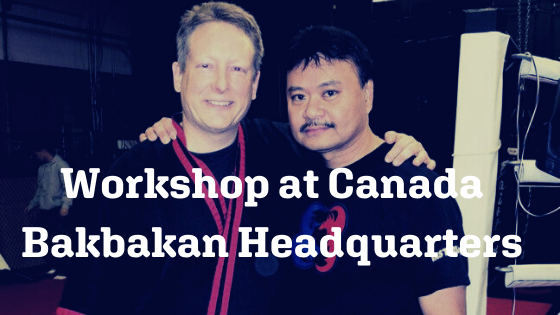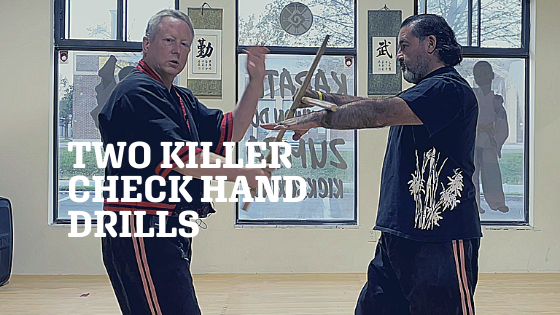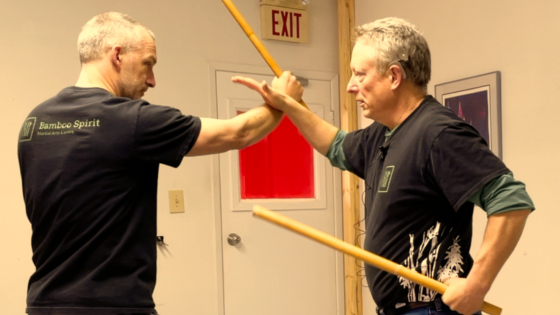Timing, Speed and Rhythm
In the past year, I have pondered how to teach my students speed, timing, and rhythm.
I have noticed the tendency of many to be “clocklike” in their timing and rhythm. This makes them predictable. In other words, their technique is usually “ONE-TWO, ONE-TWO, ONE-TWO.” In musical terms, they are thinking of “the whole beat.” This makes them predictable. Adherence to the “whole beat” turns the technique into a “formula,” a “pattern,” or a “habit.” An opponent who knows how to use “broken rhythm” will have the advantage over one not knowing how to utilize rhythm.
Watching Professor Presas play, I was always amazed by how he was several steps ahead of his training partner.
His superb timing and rhythm dictated his opponent’s responses and thereby being set up in the process. Speed was not the decisive factor.
Undoubtedly, there is a place for learning the gross motor movement of techniques. There also is a place for learning how to bait, trap, lock, hit, butt, push, punch, counter, off-balance, and sweep your opponent.
If you are not able to view this video, click here.
However, one needs to add the element of broken rhythm and timing. One needs to feel one’s opponent’s particular rhythm and break it up. In doing so, one will put him back on his heels.
The difficulty is in teaching this. Part of it is in the repetition of the various tapi-tapi techniques. A professor used to say, “Repetition is the mother of skill.” While true, I think the road to mastery is accelerated when you train with a master.
Lately, one of my students and I have been developing a set of drills incorporating the concepts of Modern Arnis. The inspiration for these drills is Master Ken Smith’s “Slap Off-Pull Off Flow Drill.” See below. In addition, the drills incorporate concepts that I’ve learned from Master Chuck Gauss.
If you can’t see the video, click here.
These concepts include the slap off, pull off, clearing, palis palis, abanico corto, switching hands, locking, etc. The drills cycle between both partners as opposed to “resetting.” We hope that the drills will teach the correct body mechanics of the major concepts of Modern Arnis. Once that is done, the next level should teach the concepts of timing and rhythm into tapi tapi. I hope that the concepts of timing and rhythm will enable the student to transfer those concepts to joint locking, empty hands, takedowns, knife work, and ground control.
If you are not able to view this video, click here.
I’ve done some beta testing among various students, and they seem to like them. I’ve noticed an improvement in their timing and rhythm. It will take time to tweak the basic drills and their variations. I admit I still have much more to learn in this area. However, this area is where I have made the most significant strides in the last few years.
Thoughts?
Additional Reading
- Four Reasons Why Filipino Martial Arts Suck
- Randomly Breaking The Rhythm
- Go With The Flow!
- How Hard Do You Really Train?
- 4 Ways To Set Up Your Opponent
Share this post:
- Click to share on Twitter (Opens in new window)
- Click to share on Facebook (Opens in new window)
- Click to share on LinkedIn (Opens in new window)
- Click to share on WhatsApp (Opens in new window)
- Click to share on Nextdoor (Opens in new window)
- Click to share on Pinterest (Opens in new window)
- Click to email a link to a friend (Opens in new window)
Brian Johns
Related Posts
3 Comments
Leave a Reply Cancel reply
Categories
- Arnis/Kali/Eskrima (113)
- Book Review (8)
- DVD Reviews (3)
- Guest Post (4)
- Inspiration (24)
- Martial Arts (99)
- My story (92)
- Safety (14)
- Tips & tricks (6)
- Uncategorized (3)
- YouTube Videos (8)






[…] This past weekend, I conducted a three-hour grading for several students. All of them are private clients. That is, they all have trained with me one-on-one since March 2020. For many, this was the first time they had seen each other since the beginning of the pandemic. The fact that they had trained only with me meant they were used to my training rhythm. […]
[…] so, I can change the pace on my terms rather than futilely trying to match my opponent’s speed. Once I grab the cane, I can go for the finishing shot. The caveat is that once I grab the cane, I […]
[…] Timing, Speed and Rhythm […]